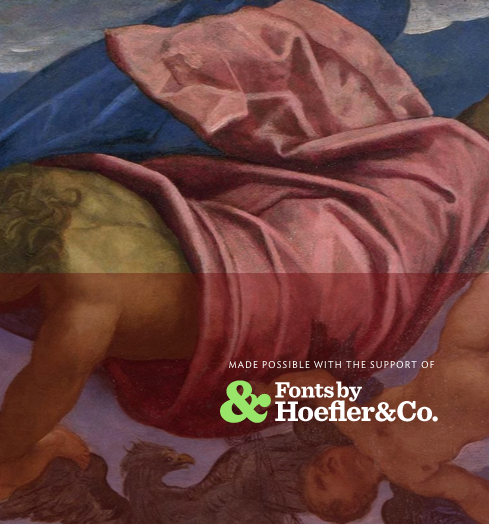Hera’s Milky Way & the origins of the Multiverse
By John Boardley From I Love Typography

abylonians, a giant serpent or length of rope. In Greek mythology, the infant Heracles was brought to suckle at the breast of a sleeping Hera, the goddess of childbirth. When she wakes, she pushes the child away and her milk splashes against the sky. The Romans, borrowing from the Greeks, called it via lactea, or ‘milky road’, and in English we know it as the Milky Way.
Header image: ‘The Origin of the Milky Way’, by Tintoretto.
For Aristotle (384–322 BC), the Milky Way was a kind of fog and not very distant; and although Democritus (460 – c. 370 BC) was perhaps the first to claim that the Milky Way was made up of many stars, the consensus, for the best part of the next 2,000 years, was that our universe comprised the earth and other planets, our sun and moon, and a few thousand stars that marked the boundary of the cosmos. That is until 1609–10, when Galileo pointed his telescope heavenward to discover that the Milky Way ‘is in fact nothing but congeries [a disorderly collection] of innumerable stars grouped together in clusters’. For the next century after Galileo, little else was learned about the Milky Way.
Wright’s Universe
Enter Thomas Wright (1711–86), born in the north of England, a teacher of mathematics, an eccentric philosopher, landscape gardener, architect, and amateur astronomer. In 1750 he published An Original Theory or New Hypothesis of the Universe. Written as a series of letters to an anonymous friend, Wright lays out, in quite simple terms, his theories on the nature of the cosmos and of the Milky Way in particular.

* It is often wrongly claimed that Wright was the first to describe the Milky Way as a flat disk; but this is based on a misinterpretation of his diagrams that were cross-sections of spherical shells. The closest he came to describing the Milky Way as a flat disk was when he proposed an alternative model where the Milky Way stars resemble the rings of Saturn. Interestingly, Kant had misinterpreted Wright after reading a review of his book that reproduced none of its illustrations. On these topics, see Minding the Heavens, pp. 66–69)
The Multiverse
Wright’s speculative theories were intriguing but mostly ignored by contemporary astronomers. However, the German philosopher Immanuel Kant ran with some of Wright’s ideas in his Universal Natural History of the Heavens (1755), in which he speculated about the existence of ‘island universes’ — and that the faint foggy patches, or nebulae (from the Latin for ‘fog’), might be distant star systems. Not until the 1780s, with the pioneering work of William Herschel, was it confirmed that the Milky Way was indeed a galaxy, our home galaxy, and was shaped like a flat disk.* Herschel’s observations at the close of the eighteenth century, followed by the work of Jacobus Kapteyn, Wilhelm Struve, and Edwin Hubble, began to reveal the true nature and scale of our Milky Way.

Wellcome Trust has a fully digitized copy of Wright’s An Original Theory of the Universe.
Wright was convinced that the universe was spherically symmetric. To cut a long story short, Wright believed that if the solar system were spherical, then it followed that the universe too was spherical. And if there were many worlds and many stars, then surely it was natural to assume that there were also many universes. But if there were in fact multiple universes, then where were Heaven and Hell located? — a question that Wright appears to have thought long and hard about.

Illustrating Heaven
By contemporary standards, some of Wright’s theories are pretty bizarre, straying as they do into astro-theology. However, the most striking feature of Wright‘s book are the magnificent illustrations, printed from engravings and mezzotints.

From the Italian, mezzo-tinto, meaning ‘half-tone’, mezzotint first developed in the seventeenth century and rose to popularity in the subsequent centuries until it was superseded by lithography in the 1800s. In a regular metal engraving, tones are achieved in the same way you might sketch with a pen or pencil, with hatching and crosshatching. However, in mezzotint, the surface of the steel or copper plate is scraped and burnished and prepared with a rocker. It permits a broad range of tones and prints beautifully rich, velvety blacks. This is exactly why Wright chose this technique for some of his darker, tonal, illustrations; for example, the plates of the night sky and the bubble-like universes. Mezzotint is an intaglio printmaking technique, so cannot be printed on the same relief printing press (letterpress) used for type and woodcuts (not enough pressure), so they are printed separately, on a roller press.

Cosmic Perspective
Only rather recently, in the twentieth century in fact, did we come to realize that the universe is pretty, pretty big. From the discovery of one galaxy, our own, to the realization that the universe is populated with billions of galaxies and trillions of stars, and that our home planet is little more than a cosmic speck in a probably infinitely large universe. And how lucky we are! ◉
For more on this story go to: https://ilovetypography.com/2019/10/22/mezzotint-milky-way-and-the-multiverse/?utm_source=feedburner&utm_medium=feed&utm_campaign=Feed%3A+ILoveTypography+%28i+love+typography%29





